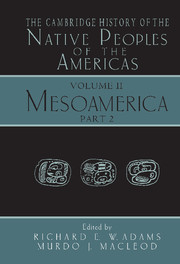Book contents
- Frontmatter
- 12 Mesoamerica Since the Spanish Invasion: an Overview
- 13 Legacies of Resistance, Adaptation, and Tenacity: History of the Native Peoples of Northwest Mexico
- 14 The Native Peoples of Northeastern Mexico
- 15 The Indigenous Peoples of Western Mexico from the Spanish Invasion to the Present
- 16 Native Peoples of Colonial Central Mexico
- 17 Native Peoples of Central Mexico Since Independence
- 18 Native Peoples of the Gulf Coast from the Colonial Period to The Present
- 19 The Indigenous Population of Oaxaca from the Sixteenth Century to the Present
- 20 The Lowland Mayas, from the Conquest to the Present
- 21 The Highland Maya
- Index to Part 2
- Map 12.1: A general map of Mesoamerica, showing major ancient, colonial, and modern population centers"
- References
14 - The Native Peoples of Northeastern Mexico
Published online by Cambridge University Press: 28 March 2008
- Frontmatter
- 12 Mesoamerica Since the Spanish Invasion: an Overview
- 13 Legacies of Resistance, Adaptation, and Tenacity: History of the Native Peoples of Northwest Mexico
- 14 The Native Peoples of Northeastern Mexico
- 15 The Indigenous Peoples of Western Mexico from the Spanish Invasion to the Present
- 16 Native Peoples of Colonial Central Mexico
- 17 Native Peoples of Central Mexico Since Independence
- 18 Native Peoples of the Gulf Coast from the Colonial Period to The Present
- 19 The Indigenous Population of Oaxaca from the Sixteenth Century to the Present
- 20 The Lowland Mayas, from the Conquest to the Present
- 21 The Highland Maya
- Index to Part 2
- Map 12.1: A general map of Mesoamerica, showing major ancient, colonial, and modern population centers"
- References
Summary
Around the year 1623 two Spaniards accompanied by their Mexicano servant set out to establish a sugar plantation in the new kingdom of Nuevo León, which for a generation had formed the northeastern frontier of New Spain. The place to which Pereyra and Pérez, the Spaniards, laid claim as their own happened to be occupied at the time by the ranchería of an Indian named Nacastlagua. Nacastlagua had his people help Pérez and Pereyra dig their irrigation ditches, prepare their fields, and plant their cane, as was expected of him and of them; yet, unexpectedly, Nacastlagua also assumed the right of sitting down first at the table every day when dinner was served. Pérez and Pereyra suffered from being so mocked by the shameless Nacastlagua, who seemed oblivious to his proper place in the Spanish scheme of things. Worse, they could think of no way to put him in that place.
But the overseer they hired for the new plantation, Antonio Durán, a bold man with no doubt some small experience in these frontier Indian affairs, soon decided to settle the matter. The day after Durán arrived, he stood waiting when dinner was served, fingering a club cut especially for the occasion. As soon as Nacastlagua sat down as was his custom, Durán set about beating the surprised and confused Indian to a pulp. The next day Antonio Durán, suspecting the denouement, packed up his household and left for the provincial capital of Monterrey.
- Type
- Chapter
- Information
- The Cambridge History of the Native Peoples of the Americas , pp. 89 - 135Publisher: Cambridge University PressPrint publication year: 2000
References
- 5
- Cited by



